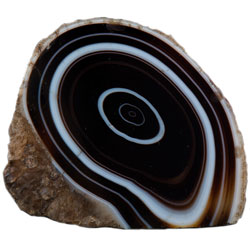

Though generally thought to be black, onyx is actually a variety of agate, microcrystalline quartz called chalcedony, that is characterized by bands of color. Onyx usually consists of bands of black and white (though sometimes found in other colors such as yellow) and is often cut in shapes that only include the back portions. With a long history of use as a carving material, onyx is usually cut as cabochons or beads, but can be used in creating striking cameos where the lighter, white bands in the carved image make a sharp contrast with the black.
| Chemical Formula | SiO2 | Mineral Class | Quartz (Chalcedony) |
|---|---|---|---|
| Color | White, Black, Banded | ||
| Crystal System | Hexagonal | Hardness | 7 |
| Transparency | Translucent to opaque | Luster | Vitreous |
| Refractory Index | 1.544 - 1.553 | Double Refraction | 0.009 |
The myth of the origin of onyx says that the goddess Venus was resting on the banks of the Indus River. As she slept, Cupid used the point of one of his enchanted arrows to give her a manicure. The parings of her nails then fell into the waters of the sacred river. Since the nails were of heavenly origin, they sank to the river bottom and were metamorphosed into onyx.
Onyx is a protective stone worn when facing adversaries in battles of conflicts of all kinds, or while hurrying down a dark street late at night. In classical ceremonial magic, the image of the head of the god Mars or a figure of the hero Hercules was engraved on onyx and carried for courage.
Indians and Persians believed that wearing onyx protected them from the evil eye, and that placing onyx on the stomach of a pregnant woman in labor would reduce the labor pain and bring on earlier delivery.
Contemporary authors say the onyx brings increased vigor, strength, stamina, and self-control. It alleviates worry, tension, and nervousness and eliminates confusion and nightmares.
A side note, onyx symbolism has many connections to bad luck. In Arabic, black onyx is known as el jaza, which means “sadness.”
A manuscript from 1875 notes that in China, slaves and menial servants mined onyx. Nobody would willingly touch or own this gem for fear of bad dreams, misfortune, and loss of energy. Although merchants couldn’t sell onyx in China, they brought it west and sold it to the unwary there.
In 1560, noted mathematician and astrologer Girolamo Cardano wrote that, in India, onyx was used to cool love’s ardor.
Scott Cunningham (1956-1993), an author who practiced Wicca, describes onyx as useful for temporarily dampening the sex drive or containing energy of any kind.